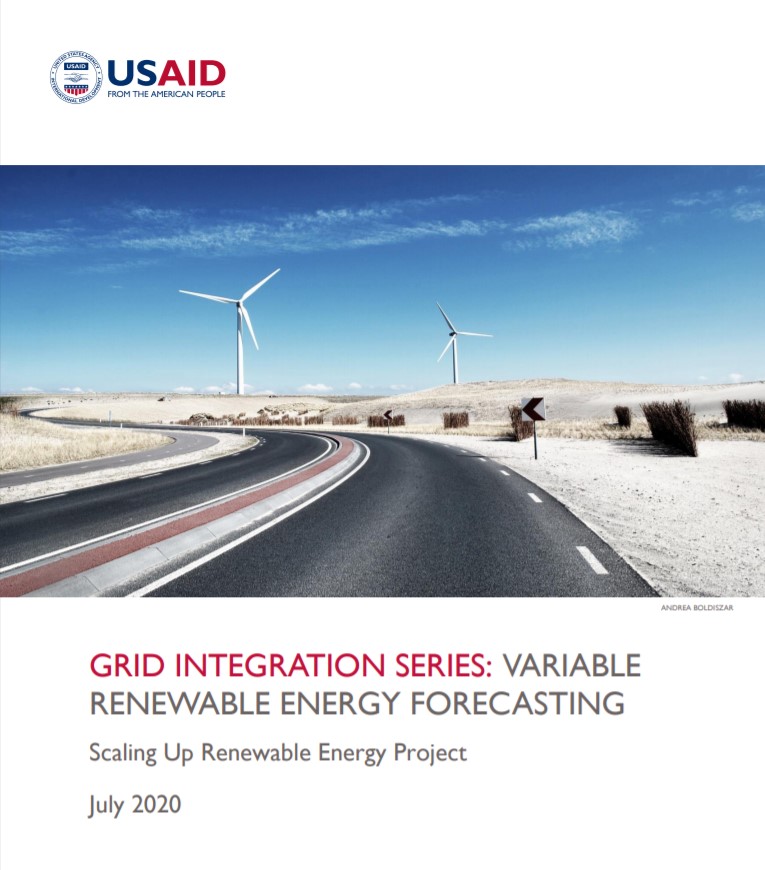USAID has published a whitepaper that we wrote as part of the Scale Up of Renewable Energy project.
https://www.usaid.gov/energy/auctions/vre-forecasting
It is a primer on variable renewable energy forecasting.
Abstract:
In most grids worldwide, the cost of utility-scale variable renewable energy (VRE) has reached grid parity, matching or beating the cost of fossil fuel–based generation. In others, the cost of VRE is fast approaching grid parity. This phenomenon of falling VRE generation costs is likely to lead to an increase in the penetration of VRE in all grids.
High penetration of VRE is a new phenomenon, as is VRE forecasting. The California Independent System Operator was the first to implement forecasting in 2004.1 Grid operators and policy makers believed high VRE penetrations could be achieved only by having a large amount of reserves, and some even contemplated requiring an amount of reserves equal to the amount of VRE in the grid. The thinking was that since VRE is variable and uncertain, a full backup would be required (making the cost of integrating VRE extremely high).
Fortunately, this did not come to pass, and VRE forecasting can take the bulk of the credit. In advanced VRE markets with accurate forecasting, the increase in statutory reserves is modest, thereby ensuring a modest cost to integrate VRE. For example, the Electric Reliability Council of Texas (ERCOT) reduced its operating reserve requirement through a variety of interventions. These included reducing the forecast lead time and the intervals between dispatches from 15 to 5 minutes.
VRE forecasting has emerged as a cost-effective method for reducing the impact of VRE integration on the grid, and it provides four key benefits that are essential to emerging market grid operators and regulators:
• Reduces reserve requirements needed to manage deviations between dispatched generation and demand, helping supply-constrained systems;
• Improves system flexibility by providing to the system operator accurate VRE generation forecasts, allowing it to optimize the entire generation fleet, which is often unutilized or underutilized;
• Reduces curtailments, allowing more renewables to be economically scheduled; and,
• Increases system reliability because better forecasting allows for significantly lower levels of volatility in the supply-demand balance, resulting in higher overall reliability levels.
VRE forecasting is also a least-cost solution to enhance grid flexibility—a requirement for increased VRE penetration. With accurate day-ahead (DA) and intraday VRE forecasting, decisions about committing, de-committing, or reducing the capacity factors of conventional generators can be made while maintaining high-reliability and low-cost generation. Without VRE forecasting, or with less accurate forecasting processes, it is not possible to adjust the level of production from inflexible conventional generators, leading to the curtailment of VRE. VRE forecasting provides the tools to exploit the flexibility of all conventional generators and thus reduce curtailments and increase VRE penetration.
VRE forecasting has become an indispensable tool for system operators in grids with modest to large amounts of VRE, with and without a real-time power market. The focus of this white paper is on emerging VRE markets with no real-time power market. In such markets, VRE forecasting improves the core functions of system operations: unit commitment, economic dispatch, real-time balancing of supply and demand, and reserves planning. Indeed, VRE forecasting is part of a portfolio of tools and processes that enable the greening of the grid.
For countries that are new to VRE or have not implemented a comprehensive VRE forecasting program, a road map informed by best practices should include:
• Development of policy and regulatory design;
• Addition of VRE forecasting requirements to the grid code;
• A centralized VRE forecasting system pilot project;
• Migration to faster dispatching; and,
• Improvements in weather forecasting.
Since VRE is likely to be a primary source of generation soon, it is recommended that these countries adopt VRE forecasting as a key tool for integrating new or additional VRE into the grid.
